Microsoft Word DOCX – import config usage
For creating a PSML file from a DOCX document.
For the default word-import-config.xml, see the default config example.
Additional information regarding support for DOCX in PageSeeder is:
The Word import process can only import to the default PSML structures. There are some structures available in PSML that require custom configuration, and further editing to the imported content is needed once in PSML. Content for the following requires further editing once imported:
- Citations – for further information, see How to import xrefs, captions and citations from DOCX.
- Glossary
- Index
- Placeholders
- Properties fragments
Overview
Editable by developers or technically-minded end users, the word-import-config.xml modifies the conversion of Word DOCX files to PSML. Changing the file requires familiarity with XML syntax, and a solid understanding of Microsoft Word. Depending on the import workflow, modifying the word-import-config.xml might require elevated permission.
The location of the default file is:
/WEB-INF/template/default/document/docx/word-import-config.xml
The word-import-config.xml does not process all properties of the .docx file format. There are many aspects of a Word document where Word provides better and more immediate feedback. This is especially true where Word controls document formatting and page layout.
PageSeeder excels in collaborative editing, managing access to the content, keeping track of changes, and the reuse of content. Therefore, the focus of the import process is:
-
Document structure – Word expresses structure explicitly, Heading 1 style contains Heading 2 styles, and implicitly, bullet items in a table cell might be seen as less important than bullet items in the Overview section. While the concepts are easy to understand, there is no formal definition or adoption of such concepts. This is exactly why the
word-import-config.xmlallows for the flexible mapping of headings, outline levels, sections, lists, and paragraphs. Where the import process splits a Word file into a hierarchical collection of files, it creates links from the references document to the component documents. -
Semantics – Extending the question of structure is that of semantics. Do the names that users create in their documents mean something? Or are they simply to help format and organize objects in the document? The lack of any uniform answer to these questions is why the
word-import-config.xmlsupports mapping the style names of paragraph, character, list, and table styles. It also supports mapping bookmarks, document types, and other IDs.
-
Linking – arguably either structure or semantics, there are many reasons why users rarely add many links to Word documents. However, the strong linking in PageSeeder, and ability of the
word-import-config.xmlto transform Word cross-references into PageSeeder xrefs and links, is worth mentioning.
Pre-import considerations
For aspects of the Word documents that the import process ignores, consideration must be given to modifying the Word, before importing it. For example, where software documentation includes code samples, replace any monospace font setting with a Word style like HTML Preformatted before importing into PageSeeder. Information that the import discards includes:
- Fonts / typefaces – operating system dependencies and font licenses make the preservation of fonts from one system to another impractical.
- Style settings – the import only processes the name (or
ID, really) of the style. Any other settings, such as indents, must be part of the mapping rule. - Measurements – there is no processing of the many measurements such as tab stops, margins, indents, column widths, line spacing, borders into PageSeeder. Exceptions include table settings that use percentages, and image size.
- Headers / footers – move any meaningful content in the headers or footers into the body of the document before importing.
- Macros – the import ignores any macro code.
- Content controls – a forms-based user interface will require building a document template.
- Fields – some DOCX field data such as bookmarks and cross-references will import automatically, other fields such as index entries and footnotes require configuration – to preserve other field content will require processing them in Word before importing.
- Security – PageSeeder has a separate permission model for accessing content, so the process ignores Word security settings.
Background
To better understand the complementary relationship between Word and PageSeeder, and the role of the word-import-config.xml, it helps to have some understanding of how Word files work.
One place to start is Microsoft Open XML and the Open Packaging Conventions . Another is a tool such as the Google Chrome browser extension for OpenXML . Alternatively, simply copy a .docx file, rename it with a .zip extension, and open the zip archive to view the underlying XML.
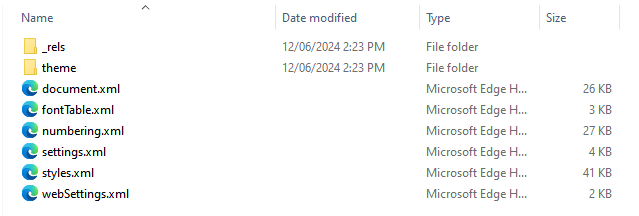
Another issue that can make a big difference is understanding how heading and paragraph numbers work in Word documents – Word numbering is famously hard to tame. Many people find this aspect of Word frustrating, but with a proper implementation, this feature works consistently and correctly. For further understanding of its complexities, consider reading Word’s Numbering Explained.
Unfortunately, the good use of Word styles is essential to get the most out of any DOCX file, and the word-import-config.xml offers some, but not much scope for improving the document quality on import.
Usage
To change from the PageSeeder default word-import-config.xml, follow the steps below:
- Sign in to PageSeeder and select a project or group.
- Select Developer mode under Account menu > Preferences.
- Project managers and administrators can change the
word-import-config.xmlfor themselves ONLY: - Click the Upload document... option (located under the Plus button on several group pages) and drop/browse a
.docxfile. - Click Import options icon, Import document as PageSeeder PSML.
- Choose +Show more options, then Edit config.
- OR, the Preview button, then config button.
- To change the default config for all groups in a project (available only to project managers and administrators):
- Click Project administration menu > Template > Template configuration,
- In the Media types table, Word import column, docx row, select override under the default option.
- To revert to the default config, click delete under the edit option in the Word import column.
For autocomplete when editing the word-import-config.xml, press ctrl-space.
Converting Word styles to PSML
Formatting
By design, there is no formatting information in PageSeeder content. This is not because formatting isn’t important, rather, it is to support the concept of separating content and format. The architectural objective for this is that the exclusion of formatting leads to:
- better reuse of content
- better productivity for writers
- more flexibility of delivery formats.
In PageSeeder, formatting is moved further along the document lifecycle, to the export stage, and adding it programmatically instead of manually, improves quality and consistency.
Getting the best import result
Using Word to get the most out of PageSeeder requires first creating a Word document with content that is consistently styled, automatically numbered, and ideally, free from manual overrides.
Word styles are mapped to PSML content and labels, using the following relationships:
- Characters – equivalent to an inline label.
- Paragraphs – equivalent to a block label.
- Tables – can be categorized in PageSeeder by the use of the @role attribute.
- Lists – can be categorized in PageSeeder by the use of the
@roleattribute on <list> or <nlist>. - Images – can have a character style.
- Metadata – map pre-defined properties.
- Fields – including footnotes, endnotes, index entries.
- References – including Xrefs and links.
Often the best way to import Word documents into PageSeeder is to clean them up first. In this circumstance, the best way to clean up Word files is in Word itself.
OX – analyse data before import
Using the OX tool can provide valuable insight about the quality of the markup in your source data.
Typical use cases include the following:
- Analysis of different markup used in source documents such as XML, PDF or DOCX file formats.
- Compare two or more XML instances and generate a report of the different XPath expressions or attribute values.
- Batch validate XML instances against XSD or Schematron schema.
- Convert documents from one format to another, including conversion rules for specific data sets.
- Convert DOCX or PDF files into a generic interim format (PageSeeder PSML) before further processing into other structures or syntaxes.
Architecturally, the idea behind OX is to allow developers to configure processing scripts into a pipeline without worrying about creating an interface for end-users who might not be comfortable using the command line. Both the OX interface and the pipelines are expressed as XML files. It can be deployed with either a user interface or as a service, or both.
OX supports processes that might require user input – see the screenshot below, where a user can add bookmarks to a PDF document one entry at a time or by pasting a list of entries into the editor. OX will process these entries to create a new PDF that is better suited for epub or other applications.
Word import – Numbering
In order to get the right results from the PageSeeder import, the word-import-config.xml and the Word document to be converted, ideally, should have the proper configuration of bullet and numbered list styles.
Users who are familiar with Word multilevel lists know their importance to enabling accurate numbering. If the numbering created from your list style works well in Word, then it will work just as well in PageSeeder.
The ways to create a new List Style are:
- Create a paragraph style for each level in the list, for example
MyList1,MyList2. - Select Define New List Style from the Multilevel List menu (not Define New Multilevel List).
- Enter a name, for example
My List, then select Numbering from the Format menu and define the numbering options for each level. - Click More and link the correct paragraph style to each level.
- Alternatively, map the Word styles
List Number,List Number 2etc. into PSML structures using the <wordstyle> element.
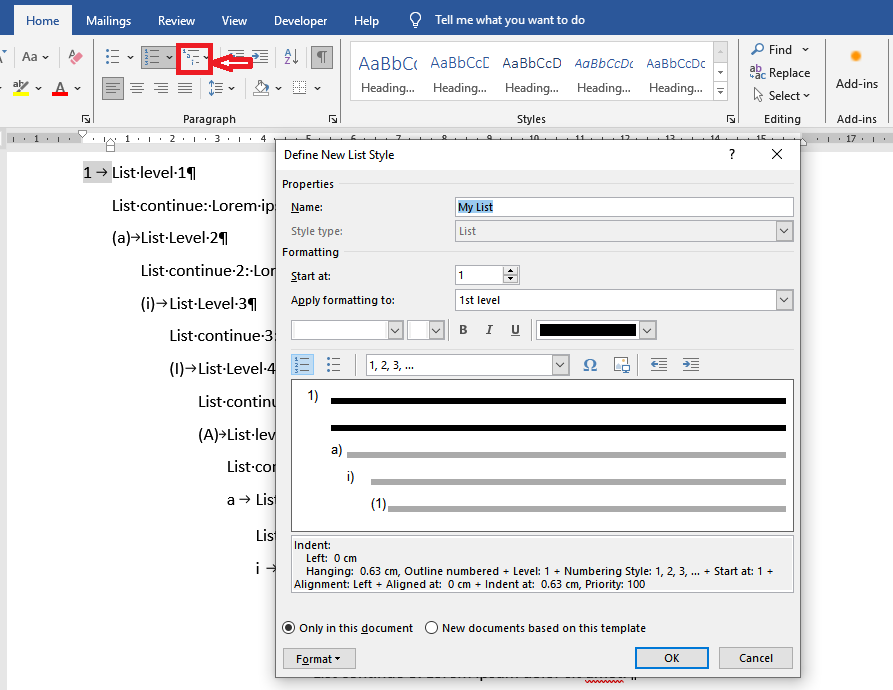

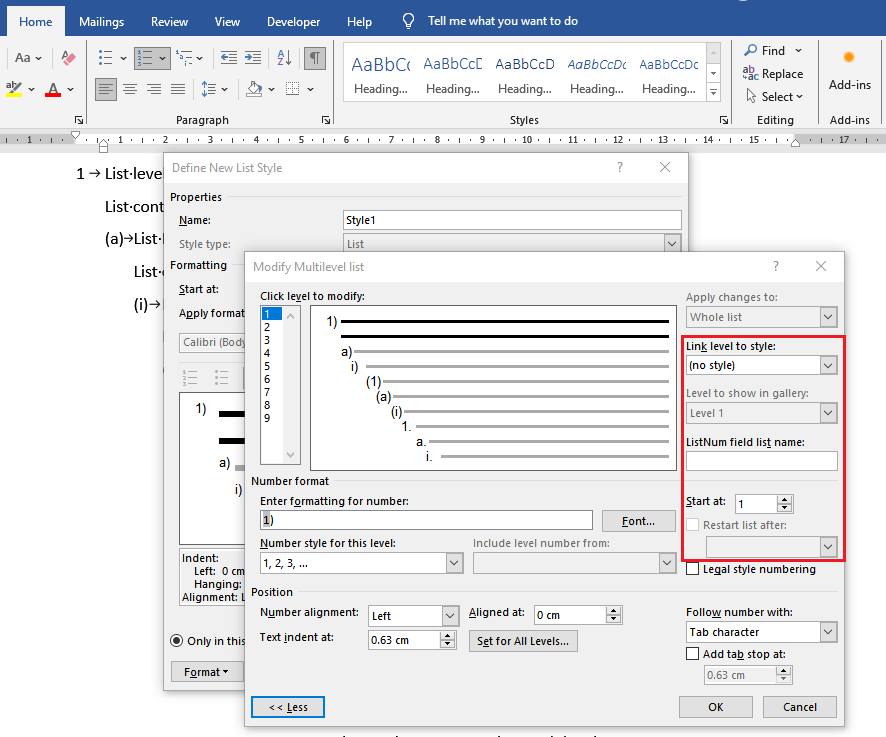
Users unfamiliar with Word multilevel lists, or list styles might find it easier to modify, or refer to, the already-configured word-import-config.xml.
For this, edit the default word-import-config.xml for your project on PageSeeder – click the
Modify the declarations in the word-import-config.xml and save the changes.
Word import config file
The information below describes different ways that the word-import-config.xml file transforms DOCX format into PSML.
In Word, styles can have multiple names, separated by commas. For the import, only the name before the first comma is processed.
In this document, references to the style ID, are not the same as the style name. The name is what Word displays in the user interface, the ID is what it uses internally. One way to see these values is to “unzip” the .docx file, and open the styles.xml file.
The ID will look like:
<w:style w:type="paragraph" w:styleId="Heading3">
but the name will be
<w:name w:val="heading 3" />
- Only refer to styles in use in the Word document.
- The heading styles built-in to Word are special – refer to them using the style ID upper case, for example,
<wordstyle name="Heading1" psmlelement="heading">. - Sometimes Word style names display as upper case but are actually lower case, if a style does not apply, try changing the reference to lower case.
Configurable import components
For an in-progress additional document to this page, see Word DOCX - import schema reference.
The following components process the conversion:
<split>– handles MathML (equations), footnotes, and endnotes.<lists>– configures lists.<styles>– translates the implied semantics and structure of Word styles into PageSeeder objects.
Store – <split>
In the import config, the <split> element relates only to mathml, footnotes, and endnotes, to control the conversion of these into files or fragments.
The import process for a Word document involves two configuration files. First is the conversion of the docx styles by processing the word-import-config.xml, then the resulting PSML content, other than that content already processed by the <split> element, is separated into files and fragments through the psml-split-config.xml file.
For more detail, see:
The <main>, <document> and <section> elements previously under <split> are obsolete as of PageSeeder v6.
<split>
<mathml select="true"
output="generate-files"
convert-to-mml="true"/>
<footnotes select="true"
output="generate-files"/>
<endnotes select="true"
output="generate-files"/>
</split>
<mathml>
This option generates files for <mathml> objects that exist in the Word document.
<mathml select="true"
output="generate-files"
convert-to-mml="true"/>
The attributes for <mathml> are:
@select– to disable the generation of<mathml>content, set select to"false", (defaulttrue).@output– setting this attribute value to"generate-files", places each<mathml>object in a separate file, under a/mathmlfolder. Setting it to"generate-fragments", places each equation in its own fragment, in a document with the pathmathml/mathml-[n].psml(defaultgenerate-fragments). Requires pso-docx version0.7.8or higher.@convert-to-mml– setting value to"true"converts equations to the original<mathml>. If the value is"false", objects retain the Office Open<mathml>syntax (defaulttrue, and alwaystrueforgenerate-fragmentsoption).
<footnotes>
This option configures Word footnote handling.
<footnotes select="true" output="generate-files"/>
The attributes for <footnotes> are:
@select– to disable generation of footnote content, set select to"false"(defaulttrue).@output– set value to"generate-files"to place each reference in a separate file under a/footnotesfolder. Selecting"generate-fragments"places each footnote in its own fragment, in afootnotes/footnotes.psmldocument (defaultgenerate-fragments).
<endnotes>
This option configures Word endnote handling.
<endnotes select="true" output="generate-files"/>
The attributes for <endnotes> are:
@select– to disable generation of endnote content, set this attribute value to"false"(defaulttrue).@output– to place each reference in a separate file under an /endnotesfolder, set this value to"generate-files". To place each endnote in its own fragment, in aendnotes/endnotes.psmldocument, set this value to"generate-fragments"(defaultgenerate-fragments).
Order and organize – <lists>
Processes Word lists, and paragraph numbering, and some manual numbering.
<lists>
<convert-to-list-roles select="false"/>
<!-- generate numbered attribute
to paragraphs for lists -->
<convert-to-numbered-paragraphs select="true">
<level value="1" output="prefix"/>
<!-- attach prefix or numbering
or inline=[label] or text -->
<level value="2" output="prefix"/>
<level value="3" output="prefix"/>
<level value="4" output="numbering"/>
<level value="5" output="numbering"/>
<level value="6" output="inline=level6"/>
</convert-to-numbered-paragraphs>
<convert-manual-numbering select="true">
<value match="^[\(|\[|\{][a-z]+[\)|\]|\}]">
<inline label="numbering-lowercase" />
</value>
<value match="^[\(|\[|\{][A-Z]+[\)|\]|\}]">
<prefix/>
</value>
<value match="^[\(|\[|\{][ivx]+[\)|\]|\}]">
<list role="numbering-roman"/>
</value>
</convert-manual-numbering>
</lists>
<convert-to-list-roles>
Adds a @role attribute to a <list> or <nlist>, with the value of the Word paragraph style. To invoke, set the @select attribute to true (default false). This attribute enables meaningful lists that store a semantic or formatting value, such as “procedures” or "guidance", that can be used for processing, validation or presentation.
<convert-to-list-roles select="true"/>
<convert-to-numbered-paragraphs>
Controls the conversion of numbered paragraph styles to numbered paragraphs or lists in PageSeeder. For numbered paragraphs, set the value of the @select attribute to true. If false, the value converts to <list> or <nlist>, depending on the type of numbered value.
<convert-to-numbered-paragraphs select="true">
The "number" in the @value attribute of the <level> element corresponds to the position in the Word list hierarchy – use 1 to 6. It converts to the "value" of the @indent on the PSML element <para>.
Paragraph numbering "display" is in the @option attribute for each <level> element. See below for examples:
-
"prefix"– to generate a prefix with the value of the current numbering value for each of the Word numbered paragraphs. -
"numbering" – to generate numbered paragraphs. -
"
inline=[labelname]"– wraps the Word paragraph number in an inline label. -
"
text" – puts the Word numbers in the paragraph content.
<convert-to-numbered-paragraphs select="true"> <-- prefix or numbering or inline=[label] or text --> <level value="1" output="prefix"/> <level value="2" output="prefix"/> <level value="3" output="text"/> <level value="4" output="numbering"/> <level value="5" output="numbering"/> <level value="6" output="inline=level6"/> </convert-to-numbered-paragraphs>
Example DOCX
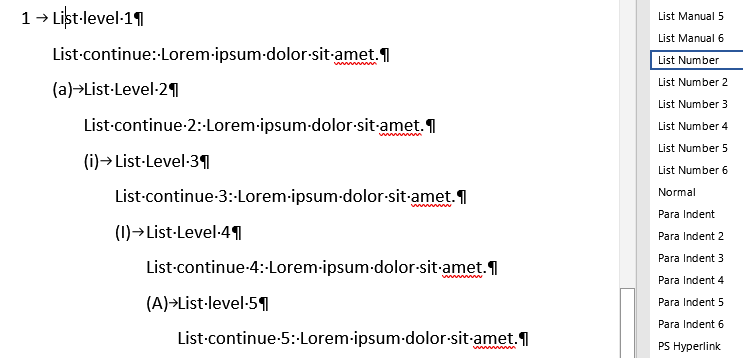
Example in PageSeeder document view mode
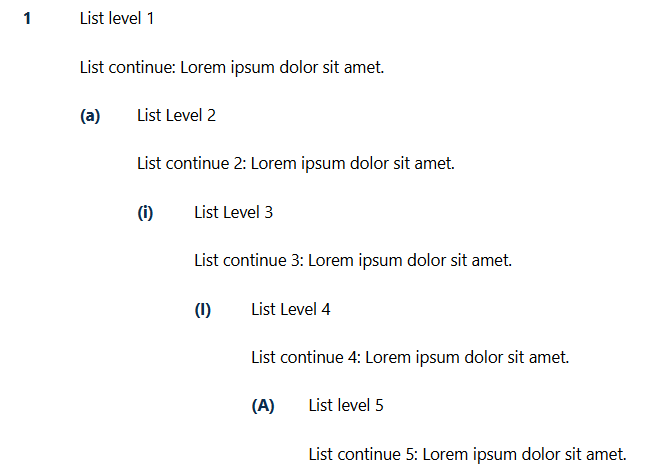
Example PSML
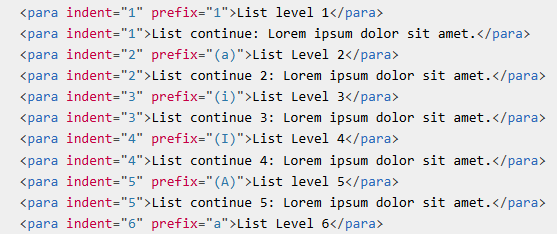
Word Style – List Paragraph
Native Word paragraph style, List Paragraph, is a complex, difficult to control concept in Word – if possible, avoid using it! It imports by default as a <para> element, with a "number" in the @indent attribute, which corresponds to the position in the Word list hierarchy.
- "Bullets" or “Numbering” list icons are selected – the Word default paragraph style is List Paragraph. Where no other Word style, either a bulleted style or numbered style, is applied to the content, it imports as a
<para>element. - No "Bullets" or "Numbering" selected – paragraph imports in a <block>. Alternatively, one of the default Word paragraph styles List Continue, List Continue 2, List Continue 3, ... can be applied to import the content in a
<para>element.
<convert-manual-numbering>
Processes non-automated numbering values in Word files. To convert manual paragraph numbering values, set the @select attribute to true.
<convert-manual-numbering select="true">
The <value> element contains a @match attribute, that has to follow the normal conventions of XSLT regular expressions (www.w3.org/TR/xslt20/#regular-expressions ).
The <value> element accepts 3 options:
-
<prefix/>– generates a@prefixattribute with the contents of the current numbering"value"for each of the Word paragraphs containing the regular expression value. -
<inline label="[numbering-format]" />– to generate an<inline>element with content equal to the current numbering"value"for each of the Word paragraphs containing the regular expression value. <autonumbering/>– generates a@numbered="true"attribute.
<convert-manual-numbering select="true">
<value match="^[\(|\[|\{][a-z]+[\)|\]|\}]">
<inline label="numbering-lowercase" />
</value>
<value match="^[\(|\[|\{][A-Z]+[\)|\]|\}]">
<prefix/>
</value>
<value match="Part [A-Z0-9]+">
<prefix />
</value>
<value match="Note:\s*">
<prefix />
</value>
<value match="\s*[0-9]+[A-Z]*$">
<autonumbering/>
</value>
</convert-manual-numbering>
Values that match the following regular expression are output in an <inline> element with an attribute of @label="numbering-lowercase".
^[\(|\[|\{][a-z]+[\)|\]|\}]
Values that match any of the following regular expressions are output as the "value" of a @prefix attribute in a <para> element.
^[\(|\[|\{][A-Z]+[\)|\]|\}]
Part [A-Z0-9]+
Note:\s*
Values that match the following regular expression output an @numbering="true" attribute.
\s*[0-9]+[A-Z]*$
Any number of <value> elements can be added, as long as the @match attribute is a valid regular expression (check www.w3.org/TR/xslt20/#regular-expressions )
Semantics and formatting – <styles>
For general transformations of DOCX styles to PSML, the options are <ignore>, <default> and <wordstyle>. There are descriptions of the examples below.
<styles>
<ignore>
<wordstyle value="TOC1" />
<wordstyle value="TOC2" />
<wordstyle value="TOC3" />
<wordstyle value="TOC4" />
</ignore>
<default>
<paragraphStyles value="block" />
<!-- possible values: 'para' or 'block' -->
<characterStyles value="inline" />
<!-- possible values: 'none' or 'inlineLabel' -->
<smart-tag keep="true" />
<!-- possible values: 'false' or 'true' -->
<references psmlelement="link" />
<!-- required when using PSML split config -->
<!--
<property name="prefix" value="true" />
possible values: 'false' or 'true'
-->
</default>
<!-- Values accepted: Word style ID of the Word style name available
in document -->
<wordstyle name="Title" psmlelement="block">
<label type="block" value="title"/>
</wordstyle>
<wordstyle name="Subtitle" psmlelement="block">
<label type="block" value="subtitle"/>
</wordstyle>
<wordstyle name="Heading1" psmlelement="heading">
<level value="1" />
</wordstyle>
<wordstyle name="Heading2" psmlelement="para">
</wordstyle>
<wordstyle name="Heading3" psmlelement="inline">
<label value="Heading3" />
</wordstyle>
<wordstyle name="Heading4" psmlelement="block">
<label value="Heading4" />
</wordstyle>
<wordstyle name="Heading5" psmlelement="heading">
<level value="5" />
<label type="block" value="Heading5" />
</wordstyle>
<wordstyle name="Heading6" psmlelement="heading">
<level value="6" />
</wordstyle>
</styles>
<ignore>
Determines the content to NOT process. For example, to discard the Table of Contents paragraphs, use the following:
<ignore> <wordstyle value="TOC1" /> <wordstyle value="TOC2" /> <wordstyle value="TOC3" /> <wordstyle value="TOC4" /> </ignore>
<default>
See examples above.
<paragraphStyles>
Process paragraph styles with no explicit mapping using <wordstyle> or <lists>, and the following options for the @value attribute:
-
"para"– Word paragraph styles with no explicit mapping are output as a PSML<para>element. -
"block"– Word paragraph styles without an explicit mapping will be output as a PSML<block>element with the"value"of a@labelattribute equal to the Word paragraph styleID(note: theIDis different from Word paragraph style name).
To get the style ID from the style name, Word strips underscores and spaces, but preserves hyphens.
<characterStyles>
Defines general rule for any character style not mapped with <wordstyle>. @value supports the following:
-
"none"– Word character styles without an explicit mapping are stripped. -
"inline" – this option converts Word character styles to a PSML<inline>element with the“value”of a@labelattribute equal to the Word character styleID(note: theIDis different from Word character style name).
<smart-tag>
Capture Word smart tag information as an inline label equal to the smart tag ID, by setting the @keep attribute value to "true". Otherwise, the import will discard smart-tag markup.
<references>
To determine whether to process internal references as PSML <link> or <xref> elements, set the @psmlelement attribute to a value of "link" or "xref" (default is "xref"). Using "link" also imports all bookmarks as <anchor> elements. Requires pso-docx v0.8.3 or higher.
<wordstyle>
These rules transform Word paragraph or character styles into the following PSML elements:
- Word paragraph styles
<heading><para><block><preformat><caption>- Word character styles:
<bold><inline><italic><monospace><underline>
There is a description of these rules below.
<wordstyle name="Heading1" psmlelement="heading">
<level value="1" />
</wordstyle>
<wordstyle name="Heading2" psmlelement="para">
</wordstyle>
<wordstyle name="Heading3" psmlelement="inline">
<label value="instruction" />
</wordstyle>
<wordstyle name="Heading4" psmlelement="block">
<label value="requirement" />
</wordstyle>
<wordstyle name="Heading5" psmlelement="heading">
<level value="5" />
<label type="block" value="Section_highlight" />
</wordstyle>
<wordstyle name="HTMLCode" psmlelement="monospace"/>
<wordstyle name="HTMLPreformatted" psmlelement="preformat"/>
<wordstyle name="TableCaption" psmlelement="caption" table="default"/>
<wordstyle name="Strong" psmlelement="bold"/>
<wordstyle name="Emphasis" psmlelement="italic"/>
<wordstyle name="IntenseEmphasis" psmlelement="underline"/>
The rules above perform the following transformations.
Creating a label through the import process requires adding that label to the PSML document template or label config in order to edit or search.
-
A Word paragraph style
IDofHeading1transforms to<heading>with an attribute@level="1". -
A Word paragraph style
IDHeading2transforms to<para>. -
A Word paragraph style
IDHeading3transforms to an<inline>label with an attribute@label="instruction". -
A Word paragraph style
IDHeading4transforms to<block>with an attribute@label="requirement". -
A Word paragraph style
IDHeading5transforms to<heading>with an attribute@level="5", and a<block>element wrapper with attribute@label="Section_highlight". -
A Word paragraph style
IDHTMLCodetransforms to<monospace>. -
A Word paragraph style
IDHTMLpreformattedtransforms to<preformat>. -
A Word paragraph style
IDTableCaptiontransforms to<caption>for all tables. -
A Word paragraph style
IDStrongtransforms to<bold>. Requires pso-docx v1.1.0 or higher. -
A Word paragraph style
IDEmphasistransforms to<italic>. Requires pso-docx v1.1.0 or higher. -
A Word paragraph style
IDIntenseEmphasistransforms to<underline>. Requires pso-docx v1.1.0 or higher.
@psmlelement
"heading"
Possible child elements are:
<wordstyle name="Heading1" psmlelement="heading"> <level value="1" /> <label type="block" value="heading1"> </wordstyle>
-
<level>with attribute@valueranging from"1"to"6". -
<label>with attributes: -
@typewith values"block"or"inline". -
@valuewith value of a[valid label name].
"para"
Possible child elements are:
<wordstyle name="paragraph1" psmlelement="para">
<indent value="1" />
<label type="block" value="para1"/>
<numbering select="true" value="inline"/>
</wordstyle>
<wordstyle name="paragraph2" psmlelement="para">
<indent value="2" />
<label type="inline" value="para2"/>
<numbering select="true" value="prefix"/>
</wordstyle>
<wordstyle name="paragraph3" psmlelement="para">
<indent value="3" />
<numbering select="true" value="inline">
<label value="num3"/>
</numbering>
</wordstyle>
-
<indent>with attribute@valuefrom"1"to"6". -
<label>with attributes of: -
@typewith values ofblockorinline. -
@valuewith value of a[valid label name]. -
<numbering>with attributes of: -
@selectwith values of"true"or"false". -
@valueoptions of: -
"inline"– requires specifying a nesting label<label value="[valid label name]">to wrap the paragraph number in. -
"text"– include the number in paragraph text. -
"prefix"– express the paragraph number as a@prefixattribute.
"Caption" and <caption>
By default, whether on an image or a table, the Word paragraph style "Caption" imports as a <block> element with label "Caption". The <block> is not inside/attached to the table or image – in the PSML it is before the <table> element, and after an <image> element. This import is useful when tables and images don’t have numbering, so can be treated the same.
Default import – <block> with label "Caption"
<wordstyle name="Caption" psmlelement="block"> <label value="Caption" /> </wordstyle>
Example PSML – table caption default import
<block label="Caption">Table 1 A caption for a default table style Table Grid</block>
<table role="TableGrid">
<col width="50%" part="header"/>
<col width="50%"/>
<row part="header">
<cell><para>Cell 1 col 1</para></cell>
<cell><para>Cell 1 col 2</para></cell>
</row>
<row>
<cell><para>Cell 1 col 2</para></cell>
<cell><para>Cell 2 col 2</para></cell>
</row>
</table>Example PSML – image caption default import
<para>Image with caption:</para>
<para>
<image src="images/image1.jpg" alt="image1.jpg" width="601" height="451"/>
</para>
<block label="Caption">Figure 1 Caption</block>
<para>Image without caption:</para>
<para>
<image src="images/image%20%2B%21%27%28%29%7E.2.jpeg"
alt="image%20%2B%21%27%28%29%7E.2.jpeg"
width="261"
height="196"/>
</para>Tables and images with different numbering (or formatting)
Where numbering (or formatting) of tables and figures differs, they need to be treated differently, so they cannot both have label @value "Caption". This mapping is also used where the captions for table and images have different foramtting.
Table captions
For tables, the default export template for the report publication type (and sample files) uses a block label @value of table-caption to output to custom Word style “Table Caption” – add this Word style to your document to import. Use the following in your word-import-config.xml.
<wordstyle name="Table Caption" psmlelement="block"> <label value="table-caption" /> </wordstyle>
Image captions
For images, the default export template for the report publication type (and sample files) uses a block label @value of figure-caption to map the default Word style “Caption” – use Word style "Caption" for image captions in your document to import. Use the following in your word-import-config.xml.
<wordstyle name="Caption" psmlelement="block"> <label value="figure-caption" /> </wordstyle>
Alternatively, you can use custom Word styles in your Word document and label @values in your import/export configuration files.
Import table captions as PSML element <caption>
Table captions can be imported as element <caption> – the content is inside/attached to the <table> element. This can also be done programmatically.
Table captions as element <caption>
To apply to all tables requires a @table attribute with a value of "default" – see the default import example above. For only specific table styles, map them using their table style ID as the @table attribute value.
- Mapping to a Word Default table style (
w:styleId="TableGrid") to a<caption>element – To import in an element <caption>, use the following in your import config:
<wordstyle name="Caption"
psmlelement="caption"
table="default"/>If you have styled table captions as Word style "Table Caption", follow this example:
<wordstyle name="Table Caption"
psmlelement="caption"
table="default"/>Example PSML
<table role="TableGrid">
<caption>Table 1 A caption for a default table style Table Grid imported in a caption element</caption>
<col width="50%" part="header"/>
<col width="50%"/>
<row part="header">
<cell><para>Cell 1 col 1</para></cell>
<cell><para>Cell 1 col 2</para></cell>
</row>
<row>
<cell><para>Cell 1 col 2</para></cell>
<cell><para>Cell 2 col 2</para></cell>
</row>
</table>- Mapping a specific/custom table design to a
<caption>element (e.g.w:styleId="tableYellow") – where table captions have Word style “Caption”, to import them in an element <caption>, use the following in your import config:
<wordstyle name="Caption"
psmlelement="caption"
table="tableYellow"/>If table captions have Word style "Table Caption", you can follow this example:
<wordstyle name="Table Caption"
psmlelement="caption"
table="tableYellow"/>Example PSML
<table role="tableYellow">
<caption>Table 2 A caption for a custom table style tableYellow</caption>
<col width="50%" part="header"/>
<col width="50%"/>
<row part="header">
<cell><para>Cell 1 col 1</para></cell>
<cell><para>Cell 1 col 2</para></cell>
</row>
<row>
<cell><para>Cell 1 col 2</para></cell>
<cell><para>Cell 2 col 2</para></cell>
</row>
</table>Deprecated
<add-numbering-to-document-titles>
The <add-numbering-to-document-titles> element is deprecated as of PageSeeder v6.
To number the document titles output from the split process, set the value of the @select attribute to "true".
<add-numbering-to-document-titles select="true"/>